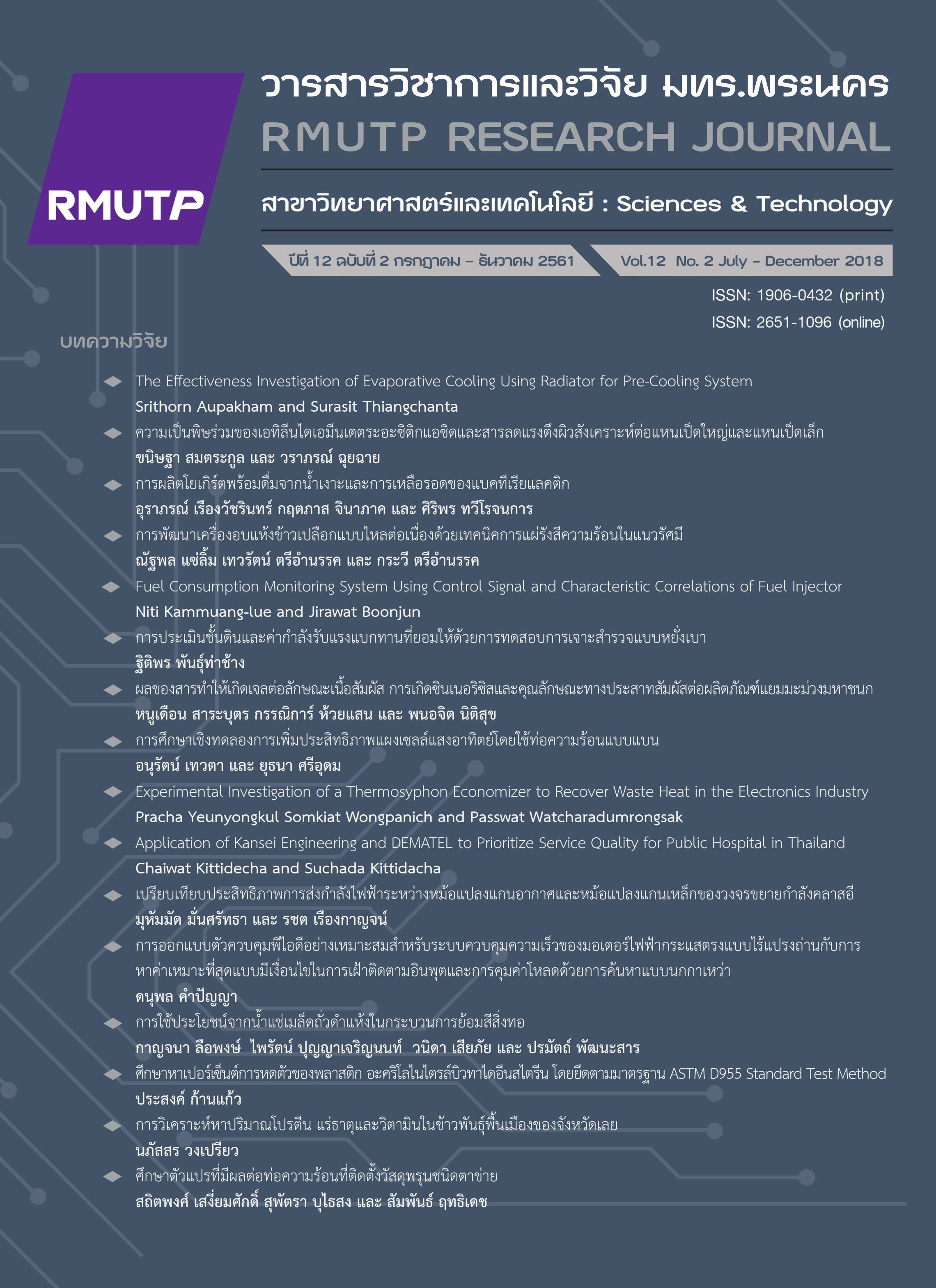ศึกษาตัวแปรที่มีผลต่อท่อความร้อนที่ติดตั้งวัสดุพรุนชนิดตาข่าย
Main Article Content
บทคัดย่อ
งานวิจัยนี้มุ่งศึกษาตัวแปรที่มีผลต่อท่อความร้อน ซึ่งเป็นการศึกษาคุณลักษณะของการถ่ายโอนความร้อนของท่อความร้อนที่ติดตั้งวัสดุพรุนชนิดตาข่าย ท่อความร้อนทำจากท่อทองแดงขนาดเส้นผ่านศูนย์กลางภายใน 10 และ 12 มิลลิเมตร ยาว 30 เซนติเมตร โดยมีวัสดุพรุนชนิดตาข่ายทองแดงติดตั้งภายในท่อ สารทำงานที่บรรจุภายในท่อความร้อน คือ น้ำกลั่น เอทานอล และ สารทำความเย็น-11 (R11) มีอัตราการเติมสารทำงาน 50 เปอร์เซ็นต์โดยปริมาตรของส่วนทำระเหย และมีการกำหนดอุณหภูมิในส่วนทำระเหยไว้ที่ 50 70 และ 90 องศาเซลเซียส โดยในส่วนควบแน่นได้รับการระบายความร้อนที่อัตราการไหลของน้ำรับความร้อน 0.5 ลิตรต่อนาที และทำการเปรียบเทียบกับท่อที่ไม่ได้ติดวัสดุพรนชนิดตาข่าย จากผลการวิจัยพบว่าท่อความร้อนที่ติดตั้งวัสดุพรุนชนิดตาข่าย ขนาดเส้นผ่านศูนย์กลางภายใน 12 มิลลิเมตร สารทำงาน R11 ที่อุณหภูมิส่วนทำระเหย 90 องศาเซลเซียส มีค่าการถ่ายโอนความร้อนสูงสุด คือ 73.3 วัตต์ และประสิทธิภาพของท่อความร้อนเป็น 58.2 เปอร์เซ็นต์ เนื่องจากวัสดุพรุนจะไปช่วยในการลำเลียงสารทำงานที่เกิดการควบแน่นที่ส่วนควบแน่นกลับมายังส่วนทำระเหย เพื่อมารับความร้อน และช่วยให้ของเหลวที่ควบแน่นกระจายตัวรอบผนังของท่อความร้อน เป็นผลให้สารทำงานที่ควบแน่นกลับสู่ส่วนทำระเหยได้ดี และส่งผลต่อค่าการถ่ายโอนความร้อนสูงขึ้น อีกทั้งสารทำงาน R11 มีจุดเดือนต่ำ และค่าความร้อนแฝงของการกลายเป็นไอสูงกว่า เอทานอล และน้ำกลั่น ตามลำดับ จึงส่งผลต่อค่าอัตราการถ่ายโอนความร้อนที่สูง
Article Details
เอกสารอ้างอิง
[2] L.L. Vasiliev, “Micro and miniature heat pipes-electronic component coolers,” Applied Thermal Engineering, vol. 28, pp. 266–273, 2008.
[3] J. Hirunlabh, P. Chantawong and J. Khedari, “A simple-low cost solar water heater for Thailand,” KMUTT Research and Development Journal, vol. 23, pp. 109-120, 2000.
[4] สถิตพงศ์ เสงี่ยมศักดิ์, สุพัตรา บุไธสง และวิริยะ แดงทน, “เครื่องทำน้ำอุ่นพลังงานแสงอาทิตย์จากท่อความร้อนที่ติดตั้งวัสดุพรุนภายใน,” การประชุมวิชาการเครือข่ายวิศวกรรมเครื่องกลแห่งประเทศไทย ครั้งที่ 31, นครนายก, ประเทศไทย, 4-7 กรกฎาคม 2560.
[5] P. Naphon, “On the performance of air conditioner with heat pipe for cooling air in the condenser,” Energy Conversion and Management, vol. 51, pp. 2362-2366, 2010.
[6] H. Akachi, F. Polasek and P. Stulc, “Pulsating heat pipes,” in Proceedings of the 5th International Heat Pipe Symposium, Melbourne, Australia, 1996, pp. 208–217.
[7] สุรเชรษฐ์ สีชำนาญ, ธีรพัฒน์ ชมพูคำ และสัมพันธ์ ฤทธิเดช, “การเพิ่มประสิทธิภาพแผงเซลล์แสงอาทิตย์โดยใช้ท่อความร้อนที่ติดตั้งวัสดุพรุนแบบตาข่ายทองแดง,” วารสารวิชาการ วิศวกรรมศาสตร์ ม.อบ. ปีที่ 9, ฉบับที่ 1, pp. 11-22, 2559.
[8] สัมพันธ์ ฤทธิเดช, “เทคโนโลยีท่อความร้อน,” มหาสารคาม: สำนักพิมพ์มหาวิทยาลัยมหาสารคาม, 2553.
[9] L. Godson Asirvatham, R. Nimmagadda and S. Wongwises, “Heat transfer performance of screen mesh wick heat pipes using silver-water nanofluid,” International Journal of Heat and Mass Transfer, vol. 60, pp. 201-209, 2013.
[10] A. Brusly Solomon, K. Ramachandran, L. Godson Asirvatham and B.C. Pillai, “Numerical analysis of a screen mesh wick heat pipe with Cu/water nanofluid,” International Journal of Heat and Mass Transfer, vol. 75, pp. 523–533. 2014.


